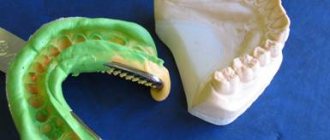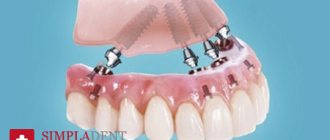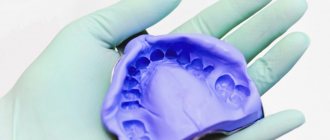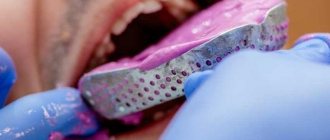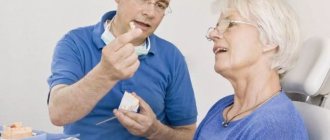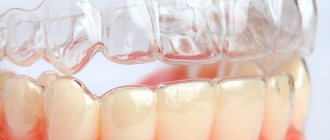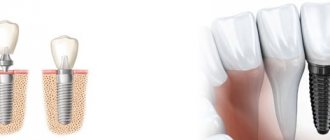Silicone impression material and mechanical manual mixing gun
An impression tray with perforations is coated with a thin layer of special adhesive. To carry out the manipulation you need: 1) a set of tools (mirror, tweezers, angled probe, smoothers of different sizes, a special shaped knife); 2) means for retraction (knitted rings or cotton threads).
Double impression technique.
As a rule, this procedure is carried out in two stages.
In the first of them, a basic dense paste (Ortosil, Zetaplus, ZM Express, Bisico, Speedex) mixed with a catalyst is applied to a release tray lubricated with adhesive and an impression is taken. At the same time, in order to create space for the corrective paste, the procedure is carried out before preparing the teeth, without removing the provisional (temporary) crowns or by first covering the impression material with a strip of thin polyethylene film. In this case, there will be some space for the clarifying (correcting) layer, which will facilitate obtaining a more accurate impression without excessive pressure on its individual areas.
Filling the tray with the main impression material (explanations in the text)
Preliminary impression of the upper jaw
After preparation, a pharmacomechanical expansion of the gingival groove (pocket) of the supporting teeth is carried out, a linen or cotton thread or a knitted ring is introduced there, pre-impregnated or ex tempore with solutions of a vasoconstrictor and an astringent.
Insertion of a retraction thread into the gingival grooves of prepared teeth: a - beginning; b- end of the procedure
Hollow cotton cylinders are used to dry (including stop bleeding from the gingival sulcus) the hard tissues of the tooth and fix the retraction thread when taking double impressions After inserting the retraction cord into the gingival sulcus, a cotton cylinder is placed into the prepared tooth. The dentition is then fused to provide a clean, dry, and open gingival sulcus. The cotton cylinder and retraction thread are removed immediately before taking the corrective impression. The first layer of the impression personalizes the standard tray with which it was produced. A layer of paste is cut off on it at the top of the roof of the palate and along the edges of the impression for its free reintroduction into the oral cavity. In addition, the interdental septa are removed to prevent compression of the interdental papillae. Finally, the outlet grooves are engraved from the tooth impressions to the top of the palatine vault, radially, to prevent elastic deformation of the impression.
Preparation of the first layer of double impression for applying the corrective mass
Then the first layer of the print is dried and filled with a low-viscosity clarifying paste (Xantopren, Oranwash, Thixoflex, Bisico, etc.).
Application of a low-viscosity corrective impression mass to obtain a clarifying impression
The threads are removed from the pockets, and the pockets themselves are dried with a stream of warm air. They can be filled with corrective paste using a special syringe with a curved cannula.
Filling gum pockets with corrective paste using a syringe with a curved cannula
You can take an impression without using a syringe by filling the impression with clarifying paste and reintroducing it into the oral cavity. After the corrective paste has hardened, the impression is removed from the patient’s mouth.
Double impression after removal from the patient's mouth
Clinical experience with one-stage, two-layer impressions
In the described clinical case, a 46-year-old patient came to the clinic to replace defective composite and amalgam fillings on teeth 14 and 15 with caries on the contact surfaces - distal 14 tooth and mesial 15 tooth (Fig. 1). It was decided to restore teeth using ceramic restorations. A special condition was that the patient had a pronounced gag reflex.
Fig 1. Initial situation
To obtain an accurate impression of a cavity prepared using a minimally invasive technique, the impression material must have the following properties:
— The correction material must be applied without air bubbles, it must remain stable in the preparation area, have optimal pressure flow properties and ensure accurate reproduction of details.
— The base material in the tray must maintain the properties of the corrective material and be of a loose consistency. In this case, preference should be given to materials with a true putty consistency and optimal resistance during application, so as not to cause a gag reflex in the patient.
— The materials must be suitable for the technique of obtaining two-layer prints and correspond to each other in curing time.
In this case, Honigum-MixStar Putty and Honigum-Light (DMG) were used as they met all the above conditions. To quickly and efficiently obtain a homogeneous mass, the base material was mixed using a MixStar-eMotion apparatus, in which the standard working time and curing time in the oral cavity were programmed. To ensure the stability of the impression after its removal, the non-perforated tray was additionally coated with DMG Tray-Adhesive. Methodology:
After removal of old restorations and caries-affected tissue, cavity preparation was carried out (Fig. 2), and a one-stage two-layer impression was taken.
Rice. 2. Preparing cavities
In the first step, the impression tray was coated with Tray-Adhesive (Fig. 3). While the assistant filled the tray with the base material Honigum-MixStar Putty (Fig. 4), the doctor filled the cavities and applied the corrective material Honigum-Light to the occlusal surfaces of the adjacent teeth (Fig. 5). During the working time (1:45 min.), the impression tray with the material was brought into the patient’s oral cavity with slight pressure in relation to the occlusal surface and fixed for at least 3 minutes. 15 sec. from the beginning of mixing. To control time (for both the doctor and the patient), the sound signals of the timers of the MixStar-eMotion device helped. At the end of the polymerization time, the impression was removed from the patient’s mouth parallel to the longitudinal axis of the teeth. The consistency of the material, which retained its elasticity even after curing, greatly facilitated this process. After drying the impression, the result was assessed visually and the impression was stored at <25ºC.
Fig 3 Fig 4
Fig 5 Fig 6
Rice. 3. Application of Tray-Adhesive
Rice. 4. Hygienic filling of the impression tray with Honigum-MixStar Putty
Rice. 5. Homogeneous, bubble-free application of Honigum-Light from the cartridge to the preparation area
Rice. 6. Perfect print quality
The combination of Honigum-MixStar Putty and Honigum-Light ensured optimal results during impression taking. Even in difficult-to-reach areas, a detailed reproduction of the entire preparation area, including the margins, was obtained. Thanks to the rheologically active matrix (excellent stability with good flow properties) of the Honigum-Light material and the consistency of the putty material (optimal resistance for the patient), there was no irritation in sensitive areas in the patient's mouth due to flowing or separation of the material.
Accurate reproduction of the preparation area using a combination of two materials was best demonstrated by the precise fit of the fabricated prosthetic structure (Fig. 7).
Rice. 7. Precise fit of the final prosthetic design
Article provided
There is a one-step method for obtaining a double impression (sandwich method).
At the same time, having filled the spoon with the main paste, the doctor makes indentations in it, in the area of the projection of the supporting teeth. A corrective infusion is injected there. It is applied from a syringe to the prepared teeth. After this, a spoon with two pastes is inserted into the oral cavity to take an impression. With a one-step method of obtaining a double impression, it is preferable to use silicone materials with a polymerization type of vulcanization, which ensures a more accurate dosage of their components (group A-silicones, for example President, Contrast, ZM Express Bisico). Modern silicone materials, a day after receiving an impression, have small volumetric changes - 0.14-0.60%, residual deformation - 0.2-0.5%, relative compression - 1.3-2.5%, reproduction of parts - 22 µm, fluidity - 0-0.1%. The shrinkage of silicone impression material is small, but the model must be cast within the first hours after taking the impression. To disinfect silicone impressions, solutions of various substances are used: hydrogen peroxide, sodium hypochlorite, glutaraldehyde, deoxane. A double impression is considered suitable if the relief of the prosthetic bed is accurately imprinted (including the contours of the gingival margin, interdental spaces, the stumps of prepared teeth, the area of the ledge) and there are no pores or smears of the relief with mucus on its surface. The basis for re-taking an impression is the following defects: • smearing of the relief due to the quality of the material (bracing) or the ingress of oral fluid or blood; • discrepancy between the impression and the future dimensions of the prosthetic bed; • lack of clear design of the edges of the print, presence of pores.
Source: Orthopedic treatment using metal-ceramic dentures. Ed. V.N. Trezubova 2007
Related materials:
- Gum retraction methods
- Preparing teeth for metal-ceramic crowns
- Preparing a patient for prosthetics with metal-ceramic prostheses
- Indications and contraindications for prosthetics with metal-ceramic prostheses
Obtaining double and updated impressions.
Silicone impression materials are used, which are available in the form of two pastes - basic and catalyst. The liquid supplied with the base paste can also be used as a catalyst.
High viscosity pastes (base and catalyst pastes or base paste and catalyst liquid) are used alone or as the first, base layer in double prints.
Low viscosity pastes (base and catalyst pastes or base paste and catalyst liquid) are used as a second or corrective layer of double impressions.
To prepare the mixture, catalyst liquid or paste is added to the required amount of base paste, measured using a paper dosage scale placed under a glass plate. They are mixed using a plastic spatula. To obtain a uniform consistency or color. A paste of dense consistency (high viscosity) is collected with special measuring cups and, after adding a catalyst liquid, mixed by hand. Mixing time is 30 – 40 seconds. Some silicone masses harden in 2.5 - 4.0 minutes, others in 5.0 - 8.0 minutes. To carry out the manipulation you need: a set of tools (mirror, tweezers, angled probe, smoothers of different sizes); means for gum retraction (knitted rings or cotton threads). Gum retraction is a pharmaco-mechanical expansion of the gingival sulcus (pocket) in order to introduce impression material into its gaping cavity to accurately depict the ledge, neck of the tooth and the bottom of the sulcus (pocket).
One-step method of obtaining a double impression (sandwich method).
Having filled the spoon with the main paste, the doctor makes a depression in it, in the area of the projection of the supporting teeth. Corrective paste is injected there. It is applied from a syringe to the prepared teeth. After this, a spoon with two pastes is inserted into the oral cavity to take an impression.
Two-step method of obtaining an impression.
Stage 1: a dense base paste mixed with a catalyst is applied to an impression tray lubricated with an adhesive (adhesive) and the impression is taken. In this case, in order to create space for the corrective paste, the procedure is carried out before preparing the teeth, either without removing the provisional crowns, or by first covering the impression material with a strip of thin polyethylene film.
After preparation, a pharmaco-mechanical expansion of the gingival sulcus of the supporting teeth is carried out, a cotton thread or a knitted ring is introduced there in advance or ex tempore, soaked in solutions of a vasoconstrictor or astringent.
After applying the retraction cord to the gingival sulcus, a cotton cylinder is placed on the prepared tooth. The dentition is then fused to provide a clean, dry, and open gingival sulcus. The cotton cylinder and retraction cord are removed before taking the impression.
Stage 2: The first layer of the impression personalizes the standard tray with which it was made. A layer of paste is cut off at the top of the palate and along the edges of the impression for its free reintroduction into the oral cavity. In addition, the interdental septa are removed to prevent compression of the interdental papillae, and the drainage grooves from the dental imprints to the top of the palatal vault are engraved, radially, to prevent elastic deformation of the impression.
Then the first layer of the impression is dried and filled with clarifying paste. The threads are removed from the pockets, and the pockets themselves are dried. They can be filled with corrective paste using a special syringe with a curved cannula. You can take an impression without using a syringe by filling the impression with clarifying paste and reintroducing it into the oral cavity.
Formation of a MOD type cavity (mesial-occlusal-distal surface of the tooth).
The MOD type cavity consists of two main cavities - mesial and distal, connected to each other by a jumper. To ensure tooth strength, the width of the bridge should not be less than 1/3 of the width of the chewing surface. A wider bridge can weaken the cavity walls and encourage spalling. In case of carious lesions of two contact surfaces, it is necessary to form a U-shaped cavity.
To prevent chipping of thinned tubercles of the chewing surface, they can be ground off. In this case, the tab becomes an overlay. Its molded chewing surface protects weakened hard tissues.
A decrease in cavity depth and the associated possible deterioration in inlay fixation can be compensated for by additional means of retention.
